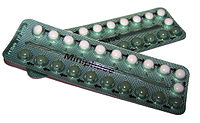
Photo from wikipedia
Purpose This study aimed to investigate radiomic features extracted from magnetic resonance imaging (MRI) scans performed before and after neoadjuvant chemoradiotherapy (nCRT) in predicting response of locally advanced rectal cancer… Click to show full abstract
Purpose This study aimed to investigate radiomic features extracted from magnetic resonance imaging (MRI) scans performed before and after neoadjuvant chemoradiotherapy (nCRT) in predicting response of locally advanced rectal cancer (LARC). Methods and Materials Thirty-nine patients who underwent nCRT for LARC were included, with 294 radiomic features extracted from MRI that was performed before (pre-CRT) and 6 to 8 weeks after completing nCRT (post-CRT). Based on tumor regression grade (TRG), 26 patients were classified as having a histopathologic good response (GR; TRG 0-1) and 13 as non-GR (TRG 2-3). Tumor downstaging (T-downstaging) occurred in 25 patients. Univariate analyses were performed to assess potential radiomic and delta-radiomic predictors for TRG in pathologic complete response (pCR) versus non-pCR, GR versus non-GR, and T-downstaging. The support vector machine-based multivariate model was used to select the best predictors for TRG and T-downstaging. Results We identified 13 predictive features for pCR versus non-pCR, 14 for GR versus non-GR, and 16 for T-downstaging. Pre-CRT gray-level run length matrix nonuniformity, pre-CRT neighborhood intensity difference matrix (NIDM) texture strength, and post-CRT NIDM busyness predicted all 3 treatment responses. The best predictor for GR versus non-GR was pre-CRT global minimum combined with clinical N stage in the multivariate analysis. The best predictor for T-downstaging was the combination of pre-CRT gray-level co-occurrence matrix correlation, NIDM-texture strength, and gray-level co-occurrence matrix variance. The pre-CRT, post-CRT, and delta radiomic-based models had no significant difference in predicting all 3 responses. Conclusions Pre-CRT MRI, post-CRT MRI, and delta radiomic-based models have the potential to predict tumor response after nCRT in LARC. These data, if validated in larger cohorts, can provide important predictive information to aid in clinical decision making.
Journal Title: Advances in Radiation Oncology
Year Published: 2020
Link to full text (if available)
Share on Social Media: Sign Up to like & get
recommendations!